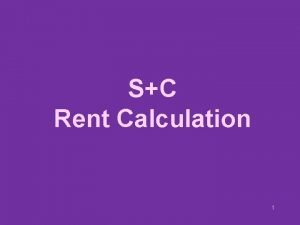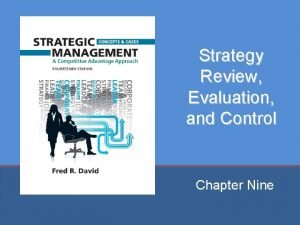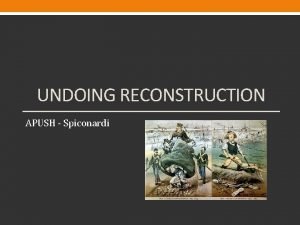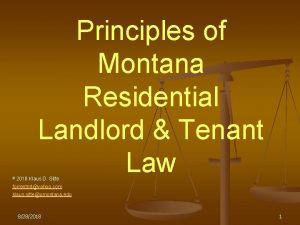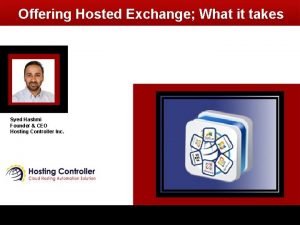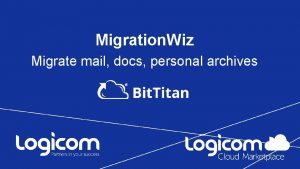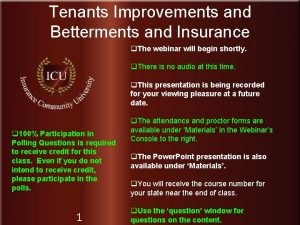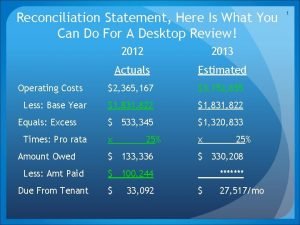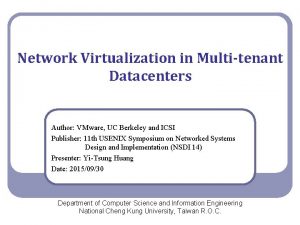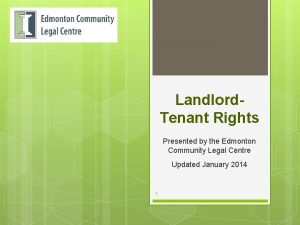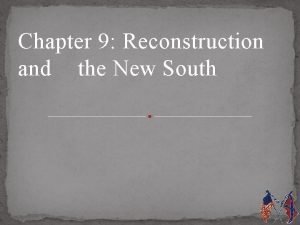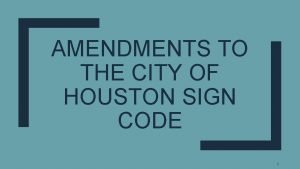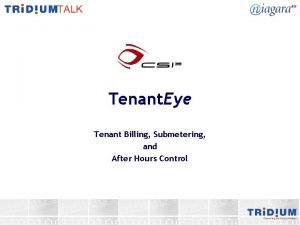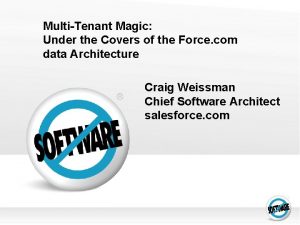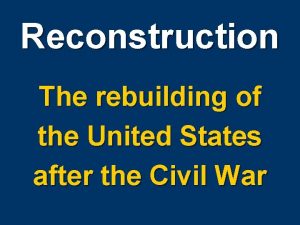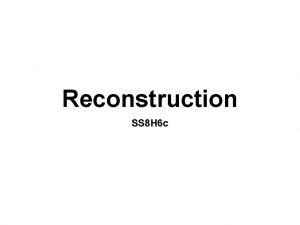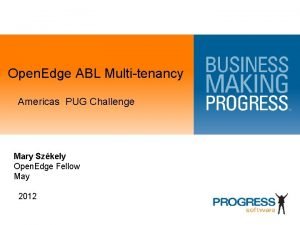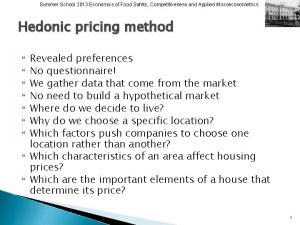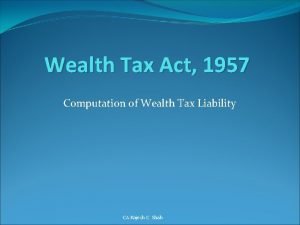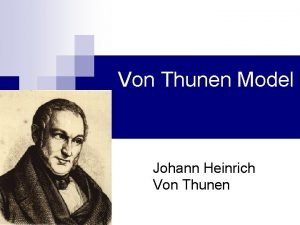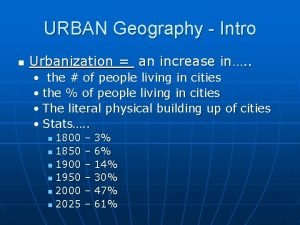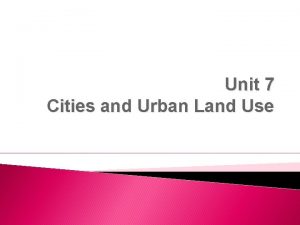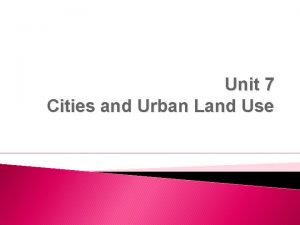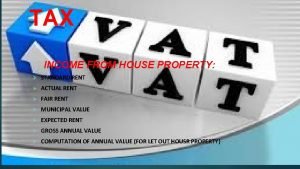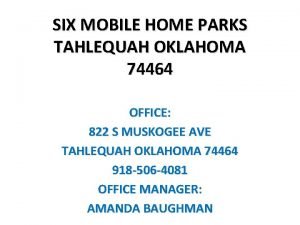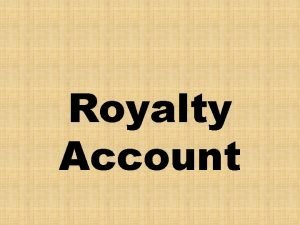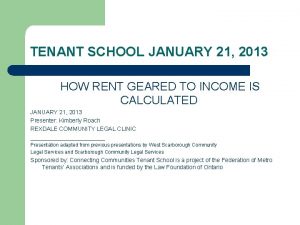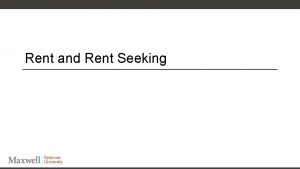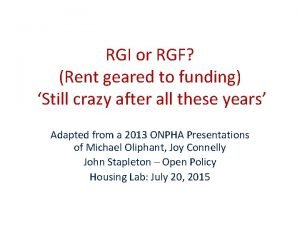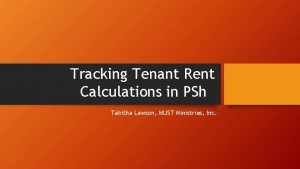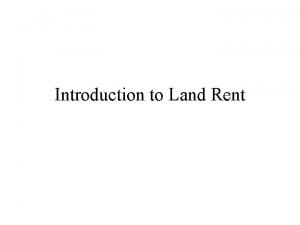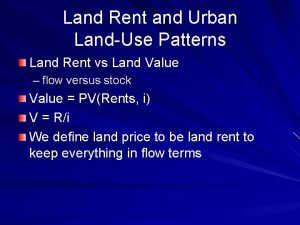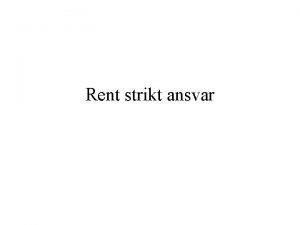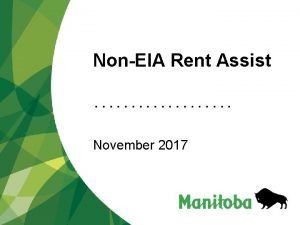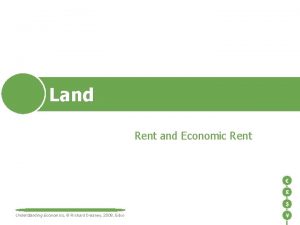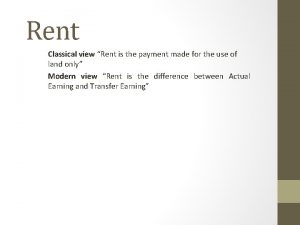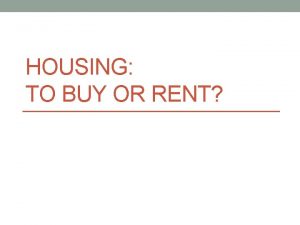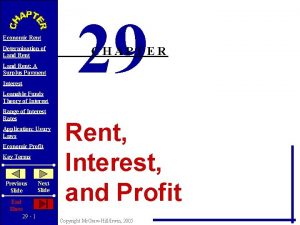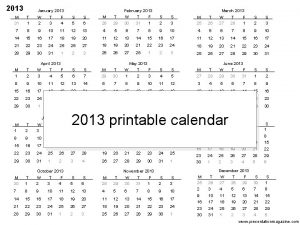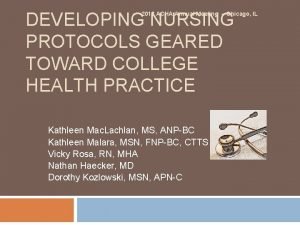TENANT SCHOOL JANUARY 21 2013 HOW RENT GEARED









































- Slides: 41

TENANT SCHOOL JANUARY 21, 2013 HOW RENT GEARED TO INCOME IS CALCULATED JANUARY 21, 2013 Presenter: Kimberly Roach REXDALE COMMUNITY LEGAL CLINIC ____________ Presentation adapted from previous presentations by West Scarborough Community Legal Services and Scarborough Community Legal Services Sponsored by: Connecting Communities Tenant School is a project of the Federation of Metro Tenants’ Associations and is funded by the Law Foundation of Ontario

l FOR THE TENANTS OF TORONTO COMMUNITY HOUSING CORPORATION (TCHC) l TIPS TO KEEP YOUR SUBSIDY l As of January 1, 2012 the Housing Services Act (HSA) applies to all tenants whose rents are fixed according to their income. Tenants living in TCHC are covered by these rules. This new law replaces the Social Housing Reform Act. l If you do not follow the new rules, TCHC can take away your subsidy. TCHC may then charge you the Market Rent for your unit, even if you have little or no income. If you lose your subsidy because you broke the rules you will eventually lose your housing.

. Reporting change l To avoid being charged Market Rent, make sure that you: l Complete and return your Annual Review forms, with all the required documents, by the date TCHC tells you. l l Report any changes in your household income or assets and provide the supporting papers to TCHC within 30 calendar days of the change. l Report any changes in the number of people living with you, within 30 calendar days of the change. l Check your mail EVERY DAY. Read everything that you receive from TCHC and immediately talk to TCHC staff about it. Write down what the Staff tells you. l If you have been asked to reply, request a review or give documents by a certain date, make sure that you do so by that date. Make a note for yourself about how and when you got the request from TCHC. l If you' re not sure what to do with the notice/letter you received OR are not satisfied with the explanation given to you by TCHC staff, contact your local legal clinic immediately. l When you give any document to TCHC staff, make sure that you keep copies of those documents for yourself and get proof that you gave them the documents. Ask the TCHC staff to date stamp your copy or sign and date your copy as proof of receipt. If you cannot get proof, write on your copy when, where and how you delivered the documents.

Request for extending time in case of delay l. If you cannot complete and return your Annual Review forms by the deadline, with all the required documents contact your Tenant Service Coordinator (TSC) or the Operating Unit (OU) manager immediately and give the reason for the delay. Ask for more time. Under the rules, TCHC is allowed to give you more time, if there is a good reason. l. If you report any changes to your household income after 30 calendar days, you can lose your subsidy and then TCHC may charge you Market Rent. Explain to your TSC or OU manager why you did not report the changes in time. If you have good reason TCHC is allowed to extend the time. You will then not lose your subsidy and will not be charged Market Rent. l. If you report an increase in the household income after 30 calendar days your rent will be recalculated and may increase retroactively. You may owe back rent. If you do not pay it TCHC may start legal proceedings to evict you for arrears of rent. Contact your local legal clinic for advice and for help to get you more time to pay.

Other rules for loss of rent subsidy l. If you or other members of your household do not try to get income from sources that may be available to you {e. g. Employment Insurance, Social Assistance, Child support, Alimony, support from sponsor and Old Age Security). l. If everyone in your household is away from the unit for more then 120 days in a row, except for medical reasons. l. If you are over-housed and you a) refuse 3 offers made to you and a year has passed since you were notified that your are over housed, or b) cancel your application on the centralized waiting list when you are over housed. l. If you own a home and do not sell it within the time given to you by TCHC. l. If you have been paying Market Rent continuously for 12 months.

HOW RENT GEARED TO INCOME IS CALCULATED l l l This is an overview of how rent is calculated according to the rules set out in Regulation 298/01 of the Housing Services Act. (HSA) The way rent is calculated has been broken into the following 5 steps: STEP 1 Identify "Family Units': "Benefit Units" and "Children of the Household " as different rules for calculating rent apply to them. STEP 2 Determine the source and monthly income of each person in the household 16 over, except for Children of the Household who are full-time students their income is exempt. Exclude any income listed under Reg. 298/01 s. 50. years old and STEP 3 Determine the Adjusted Monthly Income for each Family Unit by deducting any support payments made and any employment related deductions. Apply the OW and ODSP rent scales for each Benefit Unit. STEP 4 Calculate the Base Monthly Rent for each Family Unit and Benefit Unit. Add these amounts to get the RGI for the household. STEP 5 Add or subtract charges for utilities or other services, such as parking and cable to get the Total Rent for the Household.

STEP 1 UNITS FAMILY UNITS AND BENEFIT STEP 1 FAMILY UNITS AND BENEFIT UNITS l A Family Unit can be: – – a person and their spouse a person and any children who live with them a person, their spouse and any children who live with them l The rent of a family unit is based on income that is not from social assistance. l A Benefit Unit can be a single person or a family whose rent is based on income from social assistance - Ontario Works (OW) or ODSP. l A household can have both Family Units and Benefit Units. l Household members who have income from OW or ODSP as well as income from other sources (for example, income from employment or child support) that is above the "Non Benefit Income Limit' on the rent scale tables, are considered a Family Unit as the rent will not be based on their social assistance income.

Child of the Household A Child of the Household is defined as a child who : l is a child of any member of the household l has always lived at home except for short periods while in full-time attendance at a recognized education institution l has never had a spouse l is not the parent of a child living in the household l There is no age limit for a child of the household - a child of the household could be a 40 year old son or daughter , for example, so long as s/he meets the definition above.

DETERMINE THE MONTHLY INCOME FOR EACH PERSON IN THE HOUSEHOLD l All members of a household who are 16 years of age or older must report all their income and assets with supporting documents. l The only exception is for Children of the Household who are full-time students. (Regs. 298/01 Sec. 49(4) and City Guideline 2003 -12) They don't have to report their income if they have given verification that they attend school full-time. l Full-time attendance means taking at least 60% of a full course load. For a student with a permanent disability, full-time attendance means taking 40% of a full course load. l If the student is in full-time attendance at a post secondary educational institution (ex. , college , university, vocational school) the student must not have been out of secondary school for more than 5 years at the start of his or her study program. [City RGI Guide Ch 5, Pgs 19 &20] l

Types of Income l Income from Employment l Income from Assets and Investments l Income from Pensions or Support Agreements l Income from Social Assistance

What Income is Included l Rent can only be based on income actually received. A housing provider cannot base rent on income it thinks a person should receive - it can't deem income. l (City RGI Guide, Chapter 5, p. 2) l Income must be applied to the month in which the household should have received it. For example, if an El payment is received in Apri l, but it was a retroactive payment going back to February, the payment will be counted as income for February. l The income of a part-time student who is a Child of the Household is included l The income of a student who is not a Child of the Household is included.

RENT IS BASED ON GROSS INCOME, NOT ON TAKE HOME PAY * As people don't always receive their income in monthly amounts, the following calculation factor is used to convert gross income into monthly amounts. Daily amounts: multiply by 21. 66 to get the monthly amount. Why? Because, on average, there a little more than 20 working days in month. Weekly amounts: multiply by 4. 33 to get the monthly amount. Why? Because, on average, there a little more than 4 weeks in each month. Semi-monthly: multiply by 2 (twice a month) Bi-weekly divide by 2 and multiply by 4. 33 (every 2 weeks) Yearly amounts: are divided by 12 to get the monthly amount. l

EXCEPTION IF INCOME IS FROM SELFEMPLOYMENT l If a household member is self-employed, rent will be based on net self employment income, not gross income.

What Income is not Included (Reg. 298/01 s. 50) [City RGI Guide, Chapter 5 p 5] l l l There is a long list of excluded income in the HSA- income and payments that are not to be included in the rent calculation as income. A list from the City's Guide is attached , but here are some examples below. [City RGI - list on pgs. 5 to 9] Income tax refunds Canada Child Tax Benefit, Universal Child Care Benefit, Working Income Tax Benefit, Ontario Child Benefit and Ontario Child Care Supplement for Working Families Tax grants for people 65 or over A child benefit received from the Canada Pension Plan Survivor's death benefit from CPP A lump sum severance payment RRSP and RESP interest or dividends An inheritance A loan, including OSAP Compensation for pain and suffering And for the lucky ones, lottery winnings!!!!!!

STEP 3 DETERMINE THE ADJUSTED MONTHLY INCOME To arrive at the Adjusted Monthly Income for each household member, deduct the amount of child or spousal support payments made and employment related deductions from the gross monthly income. Deduct Child or Spousal Support Payments made [City RGI Guide, Chapter 6, p 5] l Child and Spousal payments made by a household member can be deducted from their gross monthly income. These are payments made under the Divorce Act, the Family Law Act , or under a separation agreement , a paternity agreement , a marriage contract , or a co-habitation agreement. l Deduct Employment Related Income Deduction l (Reg. 298/01 s. 50 (1) l Each Family Unit is allowed a deduction for employment related income. Employment related income includes income such as employment income, El, WSIB benefits , government training allowances. l Deduct $150. 00 from the gross monthly income if at least one person in a Family Unit with children has employment related income l Deduct $75. 00 from the gross monthly income for each person if there are no children in a Family Unit.

Income from OW or ODSP l A household member who has income from OW or ODSP and also has employment income above the non-benefit income limit is considered a Family Unit and qualifies for the Employment Related Income Deduction. Child of the Household l A Child of the Household who earns more than $75. 00 per month does not qualify for the Employment Related Income Deduction .

STEP 4 CALCULATE THE BASE MONTHLY RENT For Family Units l Take 30% of the Adjusted Monthly Income for each member of a Family Unit. For Children of the Household Who are Not Full-time Students l Take 15% of the first $1, 000. 00 of the Adjusted Monthly Income and 30% of the balance and add the two amounts together.

For Benefit Units l The 30% formula is not used to calculate rent for those who receive income from social assistance. Instead, Rent Scale Tables found in HSA Regulation 298/01, are used. (copies are attached) [City RGI Ch. 6 pg. 12]

How to use the Rent Scale Tables l l l l To use the Rent Scale Tables , you will need to know how many people are covered by the OW or ODSP cheque (this information is on the drug card) and if they have any non-benefit income. Tables 3 and 4 are used for Benefit Units who receive OW. Table 5 is used for Benefit Units who receive ODSP. Go to column 1 of the table that applies and find the row for the number of people in the benefit unit. If there is no non benefit income: Go to column 2 - Income Part of RGI for Benefit Unit. This will give you the amount of the Base Monthly Rent. If there is non-benefit income: Go to column 3 - Non Benefit Income Limit If the non-benefit income is equal to or less than the limit in column 3, go to column 2. This will give you the amount for the Base Monthly Rent. If the non-benefit income is more than the limit in column 3, calculate the Base Monthly Rent using the calculation method for a family unit, i. e. , 30% formula. The income from social assistance is not included in the rent calculation.

FOR PEOPLE WHO RECEIVE ODSP AND … – – l l Canada Pension Plan for the disabled (CPP-D), or Old Age Security (OAS) Spouse's Allowance To calculate the income part of the monthly RGI rent for these benefit units, you need to know what the ODSP "maximum basic needs allowance" is for the benefit unit. [ODSP rates table can be found in the City RGI Guide in Ch. 6 Pg. 18] If the CPP-D benefit or the Spouse's Allowance is equal to or less than the ODSP maximum basic needs allowance , use Table 5 and follow the procedure outlined above to determine the Base Monthly Rent. If the CPP-D benefit or Spouse's Allowance is greater than the ODSP maximum basic needs allowance , calculate the Base Monthly Rent by using 30% of the income from CPP-D or Spouse's Allowance. The income received from ODSP is not included in the rent calculation. Add together the Base Monthly Rent for each family or benefit unit to get the Base Monthly Rent for the household.

STEP 5 ADD OR SUBTRACT CHARGES FOR UTILITIES, SERVICES , AND OTHER CHARGES l Utilities and Services l The Base Monthly Rent is the amount charged for a unit where a housing provider supplies the following services: heat, hot water, refrigerator and stove. When a housing provider provides more services - like hydro, for example, a utility charge is added to the Base Monthly Rent. l TCHC usually refers to this as the "P-Scale" - for plus charges. The P-Scale varies depending on the extra services provided and the unit size. The P-Scale could be anywhere in the range of $30. 00 for a bachelor unit to $60. 00 for a three bedroom unit, for example. If additional services are not provided , there will be no P-Scale charge added. If fewer services than the 5 listed above are provided, a charge would be deducted from the Base Monthly Rent. (Tables in Reg. 298/01 list the amounts to be added or subtracted) l The amount obtained is the Rent-Geared-to-Income for the household

Unless… Minimum and Maximum Rent l if the amount of the rent-geared-to-income for the household is less than the minimum rent of $85. 00, the household will be charged $85. 00 l if the amount of the rent-geared-to-income for the household is more than the maximum rent (sometimes called market rent or rent cap), the household will be charged the maximum rent. Additional Charges l Add any additional charges for parking, cable, etc. , to the RGI for the household to determine the TOTAL MONTHLY GEARED TO INCOME RENT FOR THE HOUSEHOLD.

EXAMPLE 1 - PENSION INCOME l l l l A family consists of a couple, both over 65 years of age. They each receive basic Old Age Security (OAS) ($502), Guaranteed Income Supplement (GIS) ($419) and Guaranteed Annual Income System (GAINS) ($83). The P-Scale (utility charges) for their building is $30. 00. They have a parking spot and the parking charge is $50. 00. Family Unit 1. Monthly Income Adult A OAS GIS GAINS $502 $419 $83 Adult. B OAS GIS GAINS $502 $419 $83 Total Monthly Income Deductions l $2, 008 0 l l l Total Adjusted Monthly Income $2, 008 Base Rent (30% of line 4) ($2, 008 x 30%) $602 Add P-Scale+$30. 00 Add Parking Charge +$50. 00 8. Total Rent for the Household $682. 00

EXAMPLE 2 - SINGLE PARENT WITH EMPLOYMENT INCOME AND CHILD SUPPORT l l l A family consists of a single parent and one child who attendants public school. The parent is employed and earns $12. 50 per hour and works a 35 hour week. The parent also receives monthly child support of $200. The P-Scale (utility charge) for her unit is $45. 00. Family Unit Monthly Income Employment income ($12. 50/hr x 35 = $437. 50 x 4. 33 = $1894. 37/gross monthly income) (4. 33 is the multiplication factor used to convert weekly income to Monthly income) Gross Monthly Employment Income $1894. 37 Child support received + 200. 00 Total Monthly Income $2094. 37 Employment-Related Income Deduction - 150. 00 (Parent with a child) 4. Total Adjusted Monthly Income 1944. 375. Base Rent (30% of line 4)583. 3 16. Add PScale 45. 007. Total RGI Rent (Rounded down if below 50 and$628. 00$628. 31(Rounded up if above 50)

EXAMPLE 3 - EMPLOYMENT INCOME AND CHILD OF HOUSEHOLD l A father lives with his 32 year-old son. The father earns $18, 000 per year and the son earns $15. 00 per hour and works 20 hours per week. The son has always lived with his father, he is not married and he has no children. The utilities charge for their unit is $55. 00. Family Unit Monthly Income Father Employment income ($18, 000 a year + 12 = $1, 500) Total Monthly Income$1, 500. 003. Employment-Related Income Deduction- 150. 004. Total Adjusted Monthly Income$1, 350. 005. Base Rent -Father(30% of line 4)$ 405. 00 Monthly Income Son (son meets the definition of Child of the Household) Employment income ($15. 00/hr x 20 hr/week = $300. 00 x 4. 33 = $1299. /month) l Multiply first $1, 000 by 15% 150. 00 l Multiply remaining amount by 30% l ($299. x 30% = 89. 70) + 89. 70 l Base Rent - Son l ($150. 00 + 89. 70) $239. 70 Base Rent for the Household l (Add the base rent for the father and for the son) l Add P-Scale+ 55. 00 l l Total RGI Rent (over 50, round up) l l $699. 70 $700. 00 $644. 70 $1299. 00

EXAMPLE 4 - INCOME FROM ONTARIO WORKS, EMPLOYMENT, CHILD SUPPORT l l l A single parent with 3 children is in receipt of Ontario Works. She also works part-time and earns $500. 00 per month and receives child support of $200. 00 per month. The P-Scale (utilities charge) for her unit is $60. 00. Benefit Unit The calculation would look like this: – l l l l Use Table 3 - Ontario Works Rent Scale for a Benefit Unit because this parent has no spouse and one or more dependents. Go to Column 1 - number of people in the benefit unit - go down to 4 beneficiaries (mom and 3 children). Follow over to Column 3 - Non Benefit Income Limit - to see if the parent's non benefit income of $700. 00 ($500. 00 employment+ $200. 00 child support) is equal to or less than the limit. In this case, since the Non Benefit Income of $700. 00 is less than the limit of $1051. 00, the rent will be based on the amount listed in Column 2 - Income part of RGI for Benefit Unit, that is, $269. 00. Base Rent $269. 00 P-Scale + 60. 00 Total RGI Rent $ 329. 00

EXAMPLE 5 - TWO FAMILY UNITS IN SAME HOUSEHOLD A mother lives in a townhouse with her son, her daughter's 2 year old child and the child's father. Her children have always lived with her. Her 17 year old son is a full-time student. He has a part-time job and he earns l $600. 00/month. The mother is employed and she earns $12. 75/hr and works 35 hours/week. The daughter and her partner receive Ontario Works. The partner also works and earns $950. 00 a month. They pay for their own utilities and have a parking space that costs $50. 00/month. Family Unit l (The mother and the son are a Family Unit) – l l l Total Monthly Income (Mother) (12. 75/hr x 35 hrs/week=446. 25/wkx 4. 33=1932. 26)$1932. 262. Less Employment related deduction- 150. 003. Total Adjusted Monthly Income$1782. 26 The son is a Child of the Household and full-time student, therefore, his income is not included in the rent calculation. Base Rent (30°/o of $2050. 00) $ 534. 67

Benefit Unit (The daughter, her partner and child are a benefit unit) l 1. Use Table 4 - Ontario Works Rent Scale for a Benefit Unit because it applies to an individual with a spouse and one dependent. l Under Column 1 - number of people in benefit unit - follow down to 3 (daughter, partner and child) Follow across to Column 3 - Non Benefit Income Limit - for 3 beneficiaries and see if the non benefit income of$950. 00 is equal to or less than the limit. l In this case, the non benefit income of $950. 00 is more than the limit of $861. 00. This means rent will not be based on the rent scales but will be based on the gross monthly income and the calculation for a family unit will be used, i. e. , 30% formula. Any amount received from Ontario l Works will not be included in the rent calculation.

Benefit Unit (The daughter, her partner and child are a benefit unit) Cont’d l Total Monthly Income $950. 00 l 1. Less employment related deduction- 150. 00 2. Total Adjusted Monthly Income$800. 00 3. Base Rent (30°/o of $800. 00)$240. 00 4. Total RGI Rent for Household (Add mother's base rent of $534. 67 $774. 67 to the $240. 00 base rent for the daughter's family) 5. Add parking charge+ 50. 006. Total Rent for Household$824. 67 (Over. SO is rounded up)$825. 00 l l l

EFFECTIVE DATE OF RENT CHANGES AFTER A MID YEAR CHANGE OR AN ANNUAL REVIEW CHANGE Annual Review Effective Date Mid Year Change Effective Date 1 st day of 2 nd month after notice given Reg 298, s. 52 (8) 1 st day of the 2 nd month after change occurred Reg 298, s. 53(3) Decrease because of 1 st day of the month decrease in income or after notice given assets Reg 298, s. 52(7) 1 st day of the month after change occurred Reg 298, s. 53(2) Increase because of an increase in income or assets At Any Time Effective Date Household no longer eligible for RGI but not because of an increase in income 1 st day of the month following 90 days notice of decision (RTA) 60 days for Co-op (Co-operatives Corporations Act) Increase due change in policy 1 st day following 90 days notice of decision (RTA) 60 days for co-op (CCA)

EFFECTIVE DATE FOR RENT CHANGES AFTER A REVIEW OF A MID YEAR OR ANNUAL REVIEW DECISION If Original Decision was Review Decision Is Effective date is Decrease RGI Rent No change from the rent that was charged prior to mid 0 year or annual review Prior rent applies – last notice of decision is rescinded through review decision Decrease RGI Rent Decrease in RGI Rent by the same amount or different amount Date given in the original decision Decrease RGI rent Increase in RGI rent 1 st day of the month after the review body issues the decision Increase RGI Rent No change of rent from the rent that was charged mid year or annual review Prior rent applies - last notice of decision is rescinded through review decision Increase RGI Rent Increase in RGI rent by the same amount or by a lesser amount Date given in the original decision

EFFECTIVE DATE FOR RENT CHANGES AFTER A REVIEW OF A MID YEAR OR ANNUAL REVIEW DECISION CONT’D If Original Decision Was Review Decision is Effective Date is Increase RGI Rent Increase in RGI rent by a greater amount, where the original decision was the result of an administrative error The later of: 1 st day of the month after the review body issues its decision or The date given in the original decision Increase RGI Rent Increase RGI rent by greater amount, where the original decision was nit the result of administrative error Date given in the original decision Increase RGI Rent Decrease RGI Rent For annual reviews: 1 st day of the month after the housing provider issues the annual review decision For mid-year reviews: 1 st day of the month after the decision

WHERE TO FIND INFORMATION l l l l l City of Toronto Rent-Geared-to- Income Guide (Excellent plain language guide to everything you ever wanted to know about the HSA and rent calculation, but were afraid to ask. . . ) City of Toronto Guidelines (Mandatory procedures RGI providers (including TCHC!) must follow. ) Toronto Social Housing Unit Newsletter, the "Exchange" for Social Housing Providers FAQs - Toronto Social Housing Unit The Housing Services Act (HSA) and Regulations HSA Regulation 298/01 - sets out the rules fo r determination of RGI Assistance All of the above can be accessed at the City of Toronto's Social Housing Unit web site: http: //www. toronto. ca/housing/social housing/providers. htm

SOME THINGS WORTH KNOWING. . l l l l Administrative Error - Rent Calculation 0. Reg. 367/11 s. 64 (1) [City RGI Guide, Chapter 6, p 32] If a household paid less rent than they should have because the housing provider made an administrative error in the rent calculation, the household may not be required to pay back the difference between the rent paid and what the higher rent should have been. Minimum Rent [City RGI Guide, Chapter 6, p 28] The minimum rent charge is $85. 00. When the minimum rent is based on zero income, the RGI is $85. 00 and includes any charges fo r utilities. (P-Scale) Charges fo r services such as parking, cable, etc. , are extra.

SOME THINGS WORTH KNOWING l l l l Minimum rent is applied to the unit as a whole. For example , if two tenants share a unit and both have lost their jobs and have no income, the total RGI rent for the unit will be $85. 00. The tenants cannot be charged $85. 00 each. Retroactive Rent Increases For reasons other than an administrative error, the HSA allows for rent to be increased retroactively. (For example, if a tenant didn't report an increase in income right away or if El was received retroactively) Rent Decreases (City Guideline 2008 -3) If income is reduced, rent will also be reduced. Tenants do not have to wait until their next annual review to report a decrease in income. Sometimes tenants are told rent can't be "adjusted" or, income has to be reduced for 3 months before the rent can be changed , or if a tenant had no income while out of the country, that they're not eligible for a rent decrease. This is not the case. A decrease in rent takes effect on the first day of the month following the change occurs. (ex. ) Income is reduced in April , rent will decrease May 151

SOME THINGS WORTH KNOWING CONT’D l l Retroactive Rent Decreases (City Guideline 2008 -3) (Reg. 298/01 s. 53( 1)&(2) A household can report a decrease in income or assets and submit documents to verify the decrease any time up to the time of the next annual review. Because a decrease is effective on the first day of the month following the change in income, if the decrease was not reported right away, the decrease in rent will be retroactive to the first day of he month following he change. (ex. Income is reduced in January and tenant reports it in June. Decrease in rent will be applied) retroactively to February 1

SOME THING WORTH KNOWING CONT’D l l l No Provisions in the HSA to Deem Income [City RGI Guide, Chapter 5, p 3] Rent can only be based on income actually received. A housing provider cannot base rent on income it thinks a tenant should receive.

SOME THING WORTH KNOWING CONT’D l l l l Rent is calculated differently for a "Child of the Household" has a special definition in the HSA and there's a different way to calculate rent for a "child of the household" who is not a student and who earns more than $75. 00 a month. There's no age limit - a child of the household can be 40 years old, so long ass/he meets the definition below: Is a child of any member of the household Has always lived a home except for short periods while in full-time attendance at a recognized educational institution Is not the parent of a child living in the household Has never had a spouse or same sex partner The rent calculation for a child of the household is 15% of the first $1, 000. 00 of the gross monthly income and 30% of anything over $1, 000.

SOME THINGS WORTH KNOWING Students l Full-time attendance means taking at least 60% of a full course load. For a student with a permanent disability , full-time attendance means taking 40% of a full course load. Student Income is not included if: l A child of the household attends primary or secondary school l A child of the household is in full-time attendance at a recognized post secondary educational institution (ex. University, college, vocational school) and the student has not been out of secondary school for more than 5 years at the start of her or his study program. l Housing Providers are NOT to ask a child of the household who has provided documents to confirm their status as a full-time student for income documents. l (City Guideline 2003 -12 - Income of Full time Students living with their Parents) l

SOME THINGS WORTH KNOWING l l l l l Is a student who lives away from home to attend school still a member of the household? Yes, if the student meets all of these conditions: Is a child of a household member Is in full-time attendance at a recognized educational institution Lives with the household while not attending school Depends in whole or in part on the household for financial support Note: Other than a post-secondary institution (university, college, for ex. ) a school must be within the province of Ontario. (note: this means a household would not be considered over housed while the student lives away from home - student can keep her/his bedroom) If a household sends a minor child abroad to live with family to learn their language and culture, is the child still a member of the household? l No. A child living abroad and not attending university or college is not a member of the household. The household could be considered over housed when the child leaves.

SOME THINGS WORTH KNOWING l l l l OSAP Is a loan and not included as income in the rent calculation. Loans Are not included as income Self-employment Income [City Guideline 2008 -3] Net self-employment income is used to calculate the rent, not gross. Child or Spousal Support Payments made do not count as Income Court ordered support payments made by a household member can be deducted from gross income for the purpose of rent calculation. On the other hand, if child or spousal support payments are received by a household member, they count as income. A casual gift or payment of small value is not considered income A donation from a religious, charitable , or benevolent organization is not considered income. Lump Sum Severance Payment Is not included in the rent calculation. WINNING A MILLION DOLLAR LOTTERY $$$$$$$ Lottery winnings are not income for the purpose of rent calculation. But any interest or income earned from investing the winnings is income.
 Tenant rent calculation worksheet
Tenant rent calculation worksheet Marek darecki
Marek darecki Rumelt's criteria
Rumelt's criteria Minimum elevator size
Minimum elevator size Apush sharecropping
Apush sharecropping Montana tenant rights
Montana tenant rights Exchange multi tenant control panel
Exchange multi tenant control panel Beran law
Beran law Personal archive migration tool
Personal archive migration tool Microsoft dynamics real estate
Microsoft dynamics real estate Tenants improvements insurance
Tenants improvements insurance Robinhood multi-tenant model
Robinhood multi-tenant model Tenant reconciliation statement
Tenant reconciliation statement Vmware multi tenant architecture
Vmware multi tenant architecture Missouri landlord tenant law repairs
Missouri landlord tenant law repairs Rtdrs eviction representation
Rtdrs eviction representation In chapter 9 what do the tenant farmers
In chapter 9 what do the tenant farmers City of houston sign code
City of houston sign code Automatic tenant billing
Automatic tenant billing Sharecropping and tenant farming venn diagram
Sharecropping and tenant farming venn diagram Tenant magic
Tenant magic Fsa propaganda
Fsa propaganda Usda people's garden
Usda people's garden Sharecropping and tenant farming venn diagram
Sharecropping and tenant farming venn diagram Sharecropping and tenant farming venn diagram
Sharecropping and tenant farming venn diagram Compare and contrast sharecropping and tenant farming
Compare and contrast sharecropping and tenant farming Tenant translate
Tenant translate Openedge multi-tenant cloud
Openedge multi-tenant cloud Verdaderamente multi-tenant
Verdaderamente multi-tenant Summer school 2013
Summer school 2013 Net maintainable rent
Net maintainable rent Von thunen
Von thunen Von thunen model ap human geography definition
Von thunen model ap human geography definition Multiple nuclei model definition geography
Multiple nuclei model definition geography Perioheral model
Perioheral model Bid rent theory
Bid rent theory Von thunen model ap human geography
Von thunen model ap human geography Tds on conference hall rent
Tds on conference hall rent Actual rent received
Actual rent received Rent to own homes in stilwell ok
Rent to own homes in stilwell ok Right to recoup short working means
Right to recoup short working means Scarcity rent definition
Scarcity rent definition
